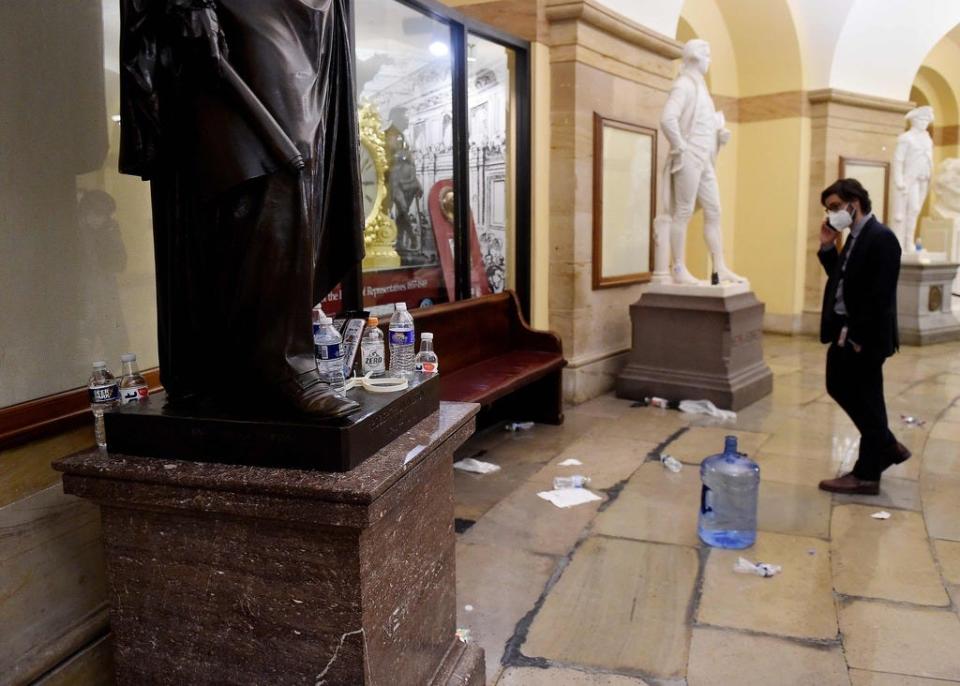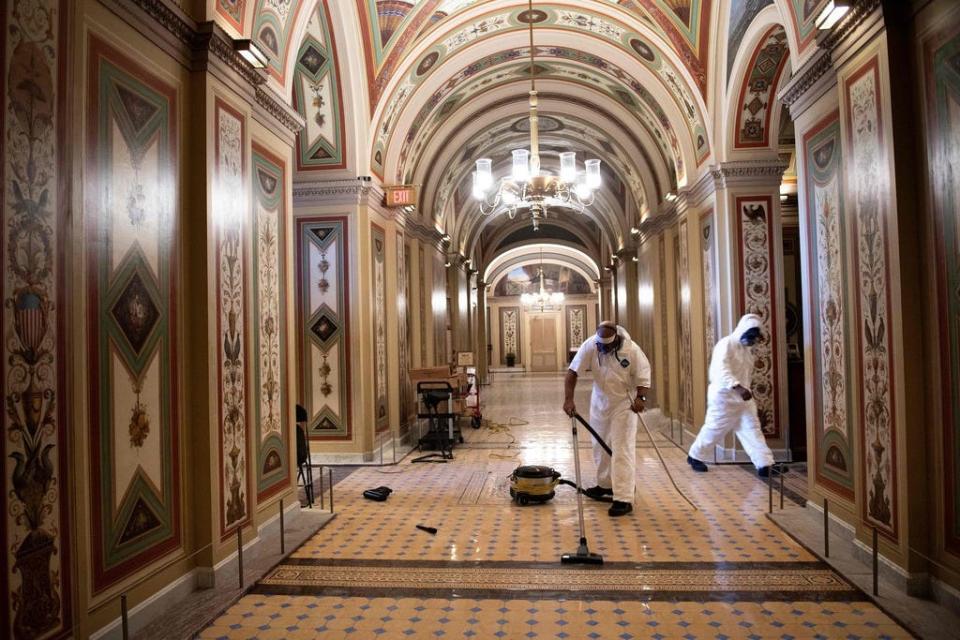Thomas Jefferson statue, James Madison portrait among artifacts damaged in Capitol riot, officials say
WASHINGTON – Chemical damage to presidential statues and paintings, the destruction of the inauguration platform, and the lasting impact on staff are among the damage top Capitol administrative officials are set to detail to lawmakers on Wednesday as they probe the aftermath of the Jan. 6 riot.
In prepared testimony for a key panel overseeing funding for legislative operations Wednesday morning, House of Representatives Curator Farar Elliott will tell lawmakers her department needs at least $25,000 for the emergency repairs and conservation of historical artifacts in the Capitol – including potential chemical damage to statues and paintings of past U.S. presidents like Thomas Jefferson, John Quincy Adams and James Madison.
The portraits and statues were among those outside the House chamber on Jan. 6, Elliott said, and they were "covered in a fine powder, likely residue from a chemical spray." She noted various sprays were used in the building on Jan. 6, including bear mace and fire extinguishers.
"Courageous staffers" spared other artifacts like a historic inkstand and the Mace of the House during the riot, Elliott says.
The testimony from the officials comes as several congressional panels investigate the riot and its aftermath. On Tuesday, senators pressed current and former law enforcement officials on the security and intelligence failures leading up to and on the day of the riot, which left five dead and resulted in multiple injuries. The House's top law enforcement official and the acting chief of the Capitol Police are set to testify again on Thursday before the same panel, and officials from the Department of Homeland Security, Department of Defense, and the FBI will testify before a Senate panel next week.
More: 'Colossal' breakdown: FBI warning not fully shared before Capitol riot; police lacked training, gear
J. Brett Blanton, the architect of the Capitol, the agency overseeing Capitol operations, will tell lawmakers about damage to the building and discuss some of the ongoing security measures at the Capitol.
The platform constructed for President Joe Biden's inauguration was "wrecked" by the rioters, Blanton is set to say.
"There was broken glass and other debris, sound systems and photography equipment was damaged beyond repair or stolen, two historic Olmsted lanterns were ripped from the ground, and the wet blue paint was tracked all over the historic stone balustrades and Capitol Building hallways," Blanton says in his prepared remarks.
His agency's first assessment of damage to the building's interior and exterior was "was broken glass, broken doors and graffiti," Blanton says, but other historical statues, murals, benches, and shutters "suffered varying degrees of damage" from chemical irritants and fire extinguishers discharged in the building.
Blanton will also disclose that the contract for the extensive fencing around the Capitol has been extended through the end of March.
Before the riot, the area around the Capitol was mostly open to the public, and the plazas were filled with runners, tourists and other visitors. But since the riot, multiple levels of fencing have surrounded the Capitol, with National Guardsmen carrying rifles patrolling the grounds.
The fencing and the escalated security presence around the Capitol has drawn lawmakers' ire.
"I want that fencing gone," Sen. Tim Kaine, D-Va., told reporters Tuesday, adding he wanted a "security plan that will keep this place safe, without it looking like a fortress."
Another official, Catherine Szpindor, the House's Chief Administrative Officer, is set to discuss the "emotional aspects" of the riot on staff and lawmakers and their Office of Employee Assistance's efforts to help.

Although physical damage to the Capitol can be repaired, "the emotional aspects of the events of January 6 are more difficult to notice and treat. After a critical incident, feelings of fear, desperation, anxiety, and depression can linger undetected or even be ignored," Szpindor says in her planned remarks.
In an ordinary year, the Office of Employee Assistance handles 3,000 conversations with employees, she says, but in the six-week period since the riot, their team has "handled over individual 1,150 interactions with employees, managers, and Members," she says.
"At this rate, counseling and consultation services in 2021 would increase by 65 percent over 2020 and by 200 percent as compared to more ‘typical’ recent years," Szpindor says.

More: Ex-Capitol police chief: Pelosi’s call for his resignation premature
This article originally appeared on USA TODAY: Capitol riot: Thomas Jefferson statue among damage, officials say

 money
money 